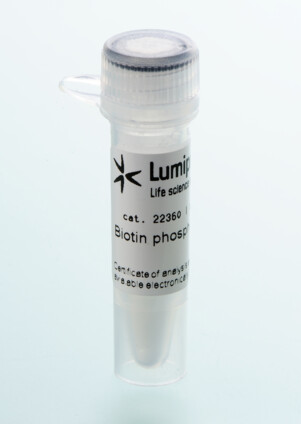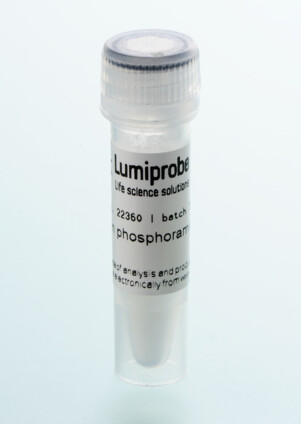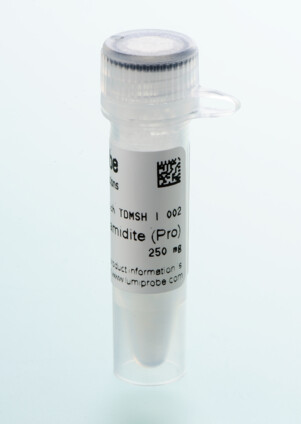- Products
- DNA
- Phosphoramidites
- Biotin phosphoramidite (hydroxyprolinol)
Biotin phosphoramidite (hydroxyprolinol)
| 货号 | 规格 | 价格 | 货期 |
|---|---|---|---|
| 22360 | 250 mg | 240.00$ | in stock |
| 42360 | 1 g | 760.00$ | in stock |
| 62360 | 5 g | 3040.00$ | in stock |
| 82360 | 10 g | please inquire | in stock |
Non-nucleosidic modifier reagent for the synthesis of biotinylated oligos based on a hydroxyprolinol core. This phosphoramidite contains a dimethoxytrityl protective group for the purification of the resulting oligos on C18 cartridges, and reverse phase HPLC. This modifier reagent can be used to introduce biotin onto 5′-position, 3′-position (using universal CPG), and internal oligo sites.
This amidite does not require special condensation and deprotection conditions.
用于合成基于羟脯氨酸核心的生物素化寡核苷酸的非核苷修饰剂。 这种亚磷酰胺含有一个二甲氧基三苯甲基保护基团,用于在 C18 小柱和反相 HPLC 上纯化所得的寡核苷酸。 该修饰剂试剂可用于将生物素引入 5′-位、3′-位(使用通用 CPG)和内部寡核苷酸位点。
这种亚酰胺不需要特殊的缩合和脱保护条件。
Biotin phosphoramidite (hydroxyprolinol)相关产品
Biotin alkyne
Biotin alkyne is a reactive affinity label which can be attached to biomolecules via Click Chemistry.
生物素炔烃是一种反应性亲和标记,可以通过点击化学连接到生物分子上。
ROX azide, 5- isomer
ROX (aka rhodamine X or rhodamine 101) azide for biomolecule labeling through Click Chemistry.
ROX(又名罗丹明 X 或罗丹明 101)叠氮化物,用于通过 Click Chemistry 进行生物分子标记。
Alkyne Phosphoramidite, 5′-terminal
Alkyne phosphoramidite for the synthesis of oligonucleotides ready for Click chemistry.
用于合成寡核苷酸的炔亚磷酰胺,可用于点击化学。
General properties
| Appearance: | white powder |
| Molecular weight: | 959.18 |
| Molecular formula: | C51H71N6O8PS |
| Solubility: | good in MeCN, DCM, THF |
| Quality control: | NMR 1H, 31P, HPLC-MS (95%), functional testing in oligo synthesis |
| Storage conditions: | Storage: 12 months after receival at -20°C in the dark. Transportation: at room temperature for up to 3 weeks. Desiccate.
储存:收到后 12 个月,在 -20°C 避光保存。 运输:在室温下长达 3 周。 干燥。 |
| MSDS: | Download |
| Product specifications |
Oligo synthesis details
| Diluent: | acetonitrile |
| Coupling conditions: | standard coupling, identical to normal nucleobases |
| Deprotection conditions: | identical to protected nucleobases |




